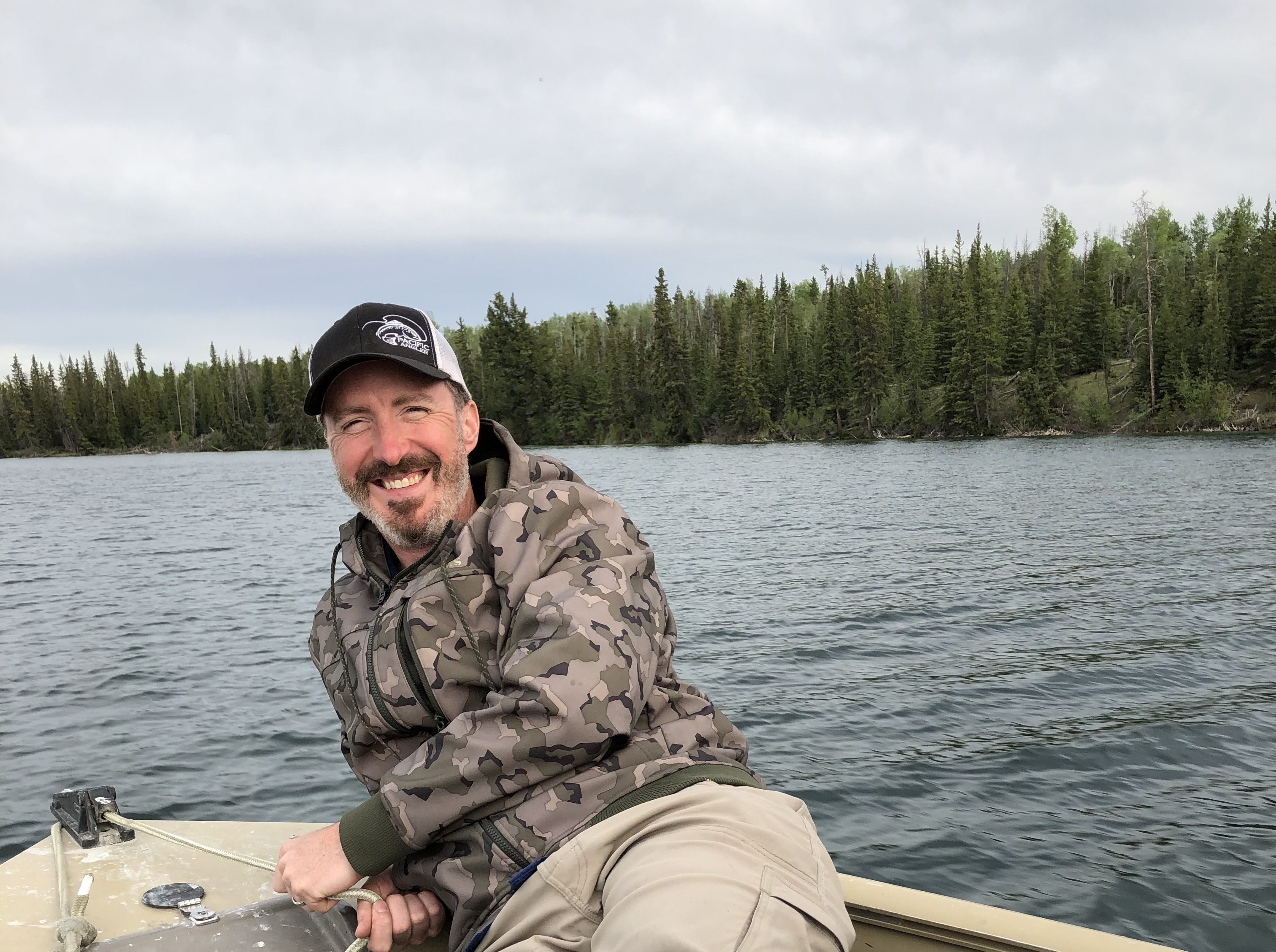
In this interview I talk with my good friend (and brother from another mother) Brian Simmers about his past work changing the culture and transforming people’s attitudes at a local non-profit provincial regulator. During his time there as Chief Financial Officer Brian worked with senior leaders to change the perspective and experiences of team members and customers from “regulatory compliance because it’s required” to “regulatory compliance because it’s good.”
Brian is an accomplished senior executive (he’s since moved on to become CFO at Providence Health Care) with a long history of leading finance, accounting, MIS, and corporate development teams. He also happens to be a loving husband and father of two, an enthusiastic fisherman, and a lover of the outdoors. When he’s not building culture and leading by example, he’s hanging out with his family at his home in Vancouver or tinkering with his Toyota Tacoma, a beautiful beast of a machine that looks like it could transform into a robot named “Badass Prime” at any moment.
Let’s start by getting your unique perspective on what workplace culture means to you?
To me, it’s something that I almost have a sense of when I walk into an organization. And it comes from [my background] being an auditor, auditing all these different companies, interviewing people, and then seeing the financial results. It’s seeing the relationship between how that company is doing, how the people are feeling, and the feeling you get when you walk in.
You can feel, “oh… this culture is in trouble,” or… “whoa, there’s something happening here, there’s a vibe, there’s an energy.”
Maybe there are things in disrepair, no one’s really paying attention, you can see it’s just not maintained or loved, people are uncomfortable, or even physically uncomfortable in their spaces. You can often quickly gauge culture by the energy of the person at the front desk. If they’re friendly and warm and welcoming, then you can guess that tone carries on to all levels of the organization.

How would you describe the culture at the regulatory agency where you previously worked?
Well, first you’re greeted by the friendliest person you’ve ever met in your life who remembers the fact that you were there a month ago and also who you were there to see. It’s a warm, inviting, bright, modern space that inspires confidence.
The values of the organization are simplicity, authenticity, an accountability. Really solid ones. The challenge was to get people to internalize them, so when I left we were actually in the process of revising and revamping our values to make them connect a little bit more and to talk about how you can apply them.
Are values and culture tied together in your mind?
I think there is a link if they’re widely known, and practiced, and recognized, and observed. It’s important that leaders are seen demonstrating the values. Let’s take “accountability” for example. We had a big Christmas party and the garbage started overflowing so I started changing garbage bags.
So I’m changing the garbage bags, and slowly, I see a few more people picking up a few things, putting away a few things. I stayed afterwards to help clean up, very intentionally and very visibly, because I care and I want people to also care.
It sounds like you were personally trying to lead culture change. How did you see the culture evolve during your time there?
The old attitude at the company was: we’re a regulator. You have no choice. You have to deal with us or there will be consequences. I realized that the attitude of our customers was that doing nothing is a hell of a lot easier than actually complying with the law, and getting in your car and coming in to visit us, or going online and filling out a whole bunch of information to obtain a permit or a license.
I realized that we were competing with doing nothing and not complying. In order to counter that we decided to make compliance a really amazing experience.
Make it super easy, promote that it actually helps you organize your work, have a record of all of the jobs that you’re working on, what status they’re at, etc. So, what if it was amazing to deal with a regulator? Would you do it more? Would you embrace it? Would you fight it less? I don’t know if that’s culture, maybe more of a strategy, but the culture’s required to support it.

Where did some of your inspiration for this kind of culture shift come from?
Part of it was modelled after an organization that I went to visit while we were building a new office. We were looking at modular wall systems and came across a company in Calgary that specializes in them. It’s a very interesting company when you go deep. We went and were welcomed right in. Actually, the night before we visited them we received a gift package with a branded house coat and slippers, and chocolate! They want to make you feel comfortable because they know you’ve traveled to see them.
When we got there everyone welcomed us, saying things like, “Hey, can I get you coffee? Come on in!” There were dogs running around and a slide and they have this cafeteria where everyone’s putting away their own plates.
I had lunch and dinner there, and someone just walked by and said, “Hey, can I grab that?” and they put my dishes away and I’m thinking, “Who are these people that actually care?”
Obviously, they get a lot of visitors, so they’ve got it down. But you feel like you’re in their house. The CEO walked by with his grandson, sat down and was like “Hey, what are you here for? What’s going on?” You know, just chatting us up. And I thought, “Wow, these are people that care.”
How do you measure culture? How do you gauge that your culture is doing what it’s supposed to be doing?
I go back to what we talked about earlier with the feel. It’s something people feel and they comment on it. It’s observing acts of caring about the organization that are public and meaningful.
It’s people being engaged with fundraising and donating to children’s hospital and giving time to the social committee. Vibrant, healthy, and engaged people come to events, they don’t decline them.
We’ve also measured it by doing things like anonymous employment engagement surveys. One interesting question we included the last time around was, “How likely are you to do more than is expected of you of your job?” And we had a very high percentage of employees indicate that they would do or are willing to do more than what their job requires. That stood out for me. And I thought “That’s good and something is happening there.”
Can you tell me a little about your experience with culture assassins?
There was one individual I once worked with responsible for a team of people, and this person was very experienced, but met every idea, improvement, innovation, suggestion with a litany of the things that were likely to go wrong or that had gone wrong before. We were trying to innovate, but they approached everything from a deficit or risk perspective, without any real consideration of how it could be mitigated or how we could experiment with it first.
What made this person a culture assassin is that extreme cautiousness permeated down to their team, to each of the leaders, to each one of the employees, and it created this whole attitude of, “Well, we basically can’t change anything.”
This ran counter to what my CEO and I and others on the leadership team were trying to do. It also affected that person’s whole team and how they were regarded within the organization. They were never tasked with anything new and had poor relationships with other parts of the organization.
How did that situation resolve itself? Did that person change their approach?
No, that person was helped to moved on, which opened up a lot of opportunity to bring new leadership in and make the changes to the team that were necessary to change the mindset. And we saw the results: better relationships with other teams, more respect, etc.
When you replaced this person, how did you make sure that you weren’t just hiring another culture assassin?
In that specific case it was a “cultural transplant”. I hired someone from a culture that I was familiar with, someone that I had worked with before in a culture that was vibrant and successful.
I think going forward I would walk candidates around, very informally, and introduce them to totally different people and see how they interact, but also demonstrate the type of interactions that we expect. I would pay special attention to how they treat the most junior employees. That is very telling for me.

It sounds like the culture of the organization has changed quite a bit from, say, 5 years ago. Are you partially responsible for that?
Yes, I’d say so. [laughs]
I know your CEO played a big role in the culture changes. Tell me a little about the importance of her support to the work you were doing.
She was a very huge enablement piece to what I did. Very stable, long-term thinking, and she brought a focus on ethics, diversity, inclusiveness, and belonging. Also championing women, women in leadership roles, women in tech… so all those pieces were also filtered in and injected into that mix. She’s very respected, which made it easier to do stuff that seemed a bit out there on top of what was already very stable. She really helped expand my thinking and my leadership.
So to be successful, you need to have some level of support from the top?
Yes definitely, you need support from the top, autonomy, and independence, all of which I had. Leaders need to empower their people to do the right stuff.
You’re not going to be successful if you’re coming into an organization where the CEO doesn’t have the same values or doesn’t give you the autonomy to make change.
At the same time, you need to believe in what you’re doing and what you think needs to happen. You can’t read a book and say, “Yeah, I’m going to do that here” and then just do it, not really believing it. So, it’s got to be an extension of yourself. I think, early on in my career, I learned that you go to school and there are these right answers and wrong answers, and it’s very clear. And when you get in to work, there is no right and wrong. There are just your answers and what you believe in.
What are some of the changes you’ve seen that you’re most proud of? Do you feel the culture will continue now that you’re gone?
You know, I think it’s the energy, the warmth, the actual success with innovation, the success with applying ideas and seeing it through. I love seeing people take pride in their work.
When I left I said to everyone, “You don’t need me. You already know what I know. And you can do it too and you can carry it on.”
I was most proud of this being true and knowing that I had left my mark on the organization and the amazing people there.
Brian, thanks so much for caring enough to take the time and share your experiences with us!
You’re welcome, and thank you!

Mike Gibbons
Mike is one of the Co-Founders at Culture Assassins, a Vancouver-based media company dedicated to preventing the destruction of healthy, high-performing organizational cultures, and to providing people with the tools necessary to build them.
Mike is a results-driven and people-oriented business leader with more than 20 years of experience in organizational and team development, marketing and product strategy, business growth strategy, and operations. He has led multiple teams and businesses, locally and globally, most recently as a senior executive for a $100M division of a Fortune 500 company.
Mike is guided by his deeply-held beliefs in connection, curiosity, humour, empathy, and honesty. In addition to his passion for workplace culture and growth, he is an avid skier, mountain biker, and sci-fi fan.

